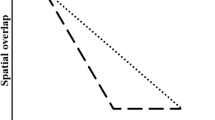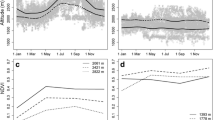Abstract
In ungulates, the rut generally leads to increased intra and interpopulation movements for males. Because movements induce energetic costs and missed feeding opportunities, they could be an indication of male mating effort. We studied space use of 44 male mountain goats (Oreamnos americanus) from three neighboring subpopulations in southeast Alaska, during the rut from 2005 to 2008. Using mixed models and an information theoretic approach with AIC, we analyzed the relationships between individual traits of males and their space use. We found no indication of breeding migration between subpopulations. Distances between individual seasonal ranges were not related to any individual trait. Daily movements, home range sizes, and total distance traveled during the rut did not vary with mass or age of individuals. As such, effects of individual traits on male space use during the rut appear weak and observed space use patterns do not support any of the main mating effort hypotheses.

Similar content being viewed by others
References
Alberts SC, Altmann J, Wilson ML (1996) Mate guarding constrains foraging activity of male baboons. Anim Behav 51:1269–1277
Alerstam T, Hedenstrom A, Akesson S (2003) Long-distance migration: evolution and determinants. Oikos 103:247–260
Bates D, Maechler M, Bolker B (2011) Linear and generalize linear mixed-effects models. CRAN package http://cran.r-project.org/web/packages/lme4/index.html
Berger J (2004) The last mile: how to sustain long-distance migration in mammals. Conserv Biol 18:320–331
Boon AK, Réale D, Boutin S (2008) Personality, habitat use, and their consequences for survival in North American red squirrels Tamiasciurus hudsonicus. Oikos 117:1321–1328
Brivio F, Grignolio S, Apollonio M (2010) To feed or not to feed? Testing different hypotheses on rut-induced hypophagia in a mountain ungulate. Ethology 116:406–415
Burnham KP, Anderson DR (2004) Multimodel inference—understanding AIC and BIC in model selection. Sociol Methods Res 33:261–304
Clutton-Brock TH (1984) Reproductive effort and terminal investment in iteroparous animals. Am Nat 123:212–229
Côté SD (2000) Dominance hierarchies in female mountain goats: stability, aggressiveness and determinants of rank. Behaviour 137:1541–1566
Côté SD, Festa-Bianchet M (2003) Mountain goat. In: Feldhamer GA, Thompson BC, Chapman JA (eds) Wild mammals of North America: biology, Management and conservation, 2nd edn. The John Hopkins University Press, Baltimore, pp 1061–1075
Dailey TV, Hobbs NT (1989) Travel in alpine terrain—energy expenditures for locomotion by mountain goats and bighorn sheep. Can J Zool 67:2368–2375
D'Eon RG, Delparte D (2005) Effects of radio-collar position and orientation on GPS radio-collar performance, and the implications of PDOP in data screening. J Appl Ecol 42:383–388
Dobson FS (1982) Competition for mates and predominant juvenile male dispersal in mammals. Anim Behav 30:1183–1192
Festa-Bianchet M (1986) Site fidelity and seasonal range use by bighorn rams. Can J Zool 64:2126–2132
Festa-Bianchet M (1991) The social system of bighorn sheep—grouping patterns, kinship and female dominance rank. Anim Behav 42:71–82
Festa-Bianchet M (1998) Condition-dependent reproductive success in bighorn ewes. Ecol Lett 1:91–94
Festa-Bianchet M, Côté SD (2008) Mountain goats: ecology, behavior, and conservation of an alpine ungulate. Island Press, Washington
Fortin D, Andruskiw M (2003) Behavioral response of free-ranging bison to human disturbance. Wildl Soc Bull 31:804–813
Gallant AL, Binnian EF, Omernik JM, Shasby MB (1995) Ecoregions of Alaska. US geological survey professional paper 1567. US government printing office, Washington, DC, USA
Geist V (1964) On the rutting behavior of the mountain goat. J Mammal 45:551–568
Gonzalez Voyer A, Smith KG, Festa-Bianchet M (2003) Dynamics of hunted and unhunted mountain goat Oreamnos americanus populations. Wildl Biol 9:213–218
Hogg JT (1984) Mating in bighorn sheep—multiple creative male strategies. Science 225:526–529
Hogg JT (2000) Mating systems and conservation at large spatial scales. In: Apollonio M, Festa-Bianchet M, Mainardi D (eds) Vertebrate mating systems. World Scientific, Singapore, pp 214–252
Jack KM, Fedigan L (2004) Male dispersal patterns in white-faced capuchins, Cebus capucinus. Part 2: patterns and causes of secondary dispersal. Anim Behav 67:771–782
Jarnemo A (2011) Male red deer (Cervus elaphus) dispersal during the breeding season. J Ethol 29:329–336
Laundré JW (1994) Resource overlap between mountain goats and bighorn sheep. Great Basin Nat 54:114–121
Mainguy J, Côté SD (2008) Age- and state-dependent reproductive effort in male mountain goats, Oreamnos americanus. Behav Ecol Sociobiol 62:935–943
Mainguy J, Côté SD, Cardinal E, Houle M (2008) Mating tactics and mate choice in relation to age and social rank in male mountain goats. J Mammal 89:626–635
Matthews PE, Heath AC (2008) Evaluating historical evidence for occurrence of mountain goats in Oregon. Northwest Sci 82:286–298
McElligott AG, Naulty F, Clarke WV, Hayden TJ (2003) The somatic cost of reproduction: what determines reproductive effort in prime-aged fallow bucks? Evol Ecol Res 5:1239–1250
Mysterud A, Holand O, Roed KH, Gjostein H, Kumpula J, Nieminen M (2003) Effects of age, density and sex ratio on reproductive effort in male reindeer (Rangifer tarandus). J Zool 261:341–344
Parga JA, Lessnau RG (2008) Dispersal among male ring-tailed lemurs (Lemur catta) on St. Catherines Island. Am J Primatol 70:650–660
Pelletier F (2005) Foraging time of rutting bighorn rams varies with individual behavior, not mating tactic. Behav Ecol 16:280–285
Pelletier F, Hogg JT, Festa-Bianchet M (2006) Male mating effort in a polygynous ungulate. Behav Ecol Sociobiol 60:645–654
Pelletier F, Mainguy J, Côté SD (2009) Rut-induced hypophagia in male bighorn sheep and mountain goats: foraging under time budget constraints. Ethology 115:141–151
Pemberton JM, Albon SD, Guinness FE, Cluttonbrock TH, Dover GA (1992) Behavioral estimates of male mating success tested by DNA fingerprinting in a polygynous mammal. Behav Ecol 3:66–75
Pépin D, Morellet N, Goulard M (2009) Seasonal and daily walking activity patterns of free-ranging adult red deer (Cervus elaphus) at the individual level. Eur J Wildl Res 55:479–486
Pianka ER, Parker WS (1975) Age-specific reproductive tactics. Am Nat 109:453–464
R Core Team (2011). R: A language and environment for statistical computing. R Foundation for Statistical Computing, Vienna, Austria, http://www.R-project.org/
Ratikainen II, Panzacchi M, Mysterud A, Odden J, Linnell J, Andersen R (2007) Use of winter habitat by roe deer at a northern latitude where Eurasian lynx are present. J Zool 273:192–199
Rogers LL (1987) Factors influencing dispersal in the black bear. In: Chepko-Sade BD, Halpin ZT (eds) Mammalian dispersal patterns: the effects of social structure on population genetics, 1st edn. University of Chicago Press, Chicago, pp 75–84
Schielzeth H (2010) Simple means to improve the interpretability of regression coefficients. Methods Ecol Evol 1:103–113
Shafer ABA, Côté SD, Coltman DW (2011) Hot spots of genetic diversity descended from multiple Pleistocene refugia in an alpine ungulate. Evolution 65:125–138
Shafer ABA, Northrup JM, White KS, Boyce MS, Côté SD, Coltman DW (2012) Habitat selection predicts genetic relatedness in an alpine ungulate. Ecology 93:1317–1329
Smith BL (1988) Criteria for determining age and sex of American mountain goats in the field. J Mammal 69:395–402
Taylor WP (2001) Wildlife capture and chemical restraint manual. Alaska Department of Fish and Game. Juneau, USA
Taylor S, Wall W, Kulis Y (2004) A GPS-telemetry study of mountain goat habitat use in south coastal B.C. Forest Investment Account, Cambell River, British Columbia
von Hardenberg A, Bassano P, Peracino A, Lovari S (2000) Male alpine chamois occupy territories at hotspots before the mating season. Ethology 106:617–630
van Overveld T, Matthysen E (2010) Personality predicts spatial responses to food manipulations in free-ranging great tits (Parus major). Biol Lett 6:187–190
White KS (2006) Seasonal and sex-specific variation in terrain use and movement patterns of mountain goats in southeastern Alaska. NWSGC Proc 15:183–193
White KS, Pendleton GW, Crowley D, Griese HJ, Hundertmark KJ, McDonough T, Nichols L, Robus M, Smith CA, Schoen JW (2011) Mountain goat survival in coastal Alaska: effects of age, sex, and climate. J Wildl Manag 75:1731–1744
White KS, Gregovich DP, Pendleton GW, Barten NL, Scott R, Crupi A, Larsen DN (2012) Mountain goat population ecology and habitat use along the Juneau access road corridor. Alaska. Final wildlife research report, Alaska Department of Fish and Game, Juneau, AK, USA
Willisch CS, Ingold P (2007) Feeding or resting? The strategy of rutting male Alpine chamois. Ethology 113:97–104
Yoccoz NG, Mysterud A, Langvatn R, Stenseth NC (2002) Age- and density-dependent reproductive effort in male red deer. Proc R Soc Lond B 269:1523–1528
Acknowledgments
We are grateful to A.-S. Julien and D. Emond for their help with statistical analysis and to J. Wilmshurst, M. Apollonio, and an anonymous reviewer for valuable comments on an earlier version of the manuscript. Funding was provided by the Alaska Department of Fish and Game, Alaska Department of Transportation and Public Facilities and Coeur Alaska. We thank J. Jemison, N. Barten, D. Larsen, R. Scott, A. Crupi, C. Rice, K. McCoy, and L. Butler for their help with capture, handling, and monitoring of mountain goats. Aerial capture support was provided by R. Madrid and M. Horton (Temsco Helicopters). Fixed-wing aerial support was provided by L. Bennett, C. Schroth, J. Norvell, M. Morris, D. Larsen, and P. Valkenburg. We thank J. Mainguy, M. Houle, E. Cardinal, and J. Taillon for their help studying the rut of goats at Caw Ridge. JHR was supported by a scholarship from Ski Marmot Basin and Parks Canada.
Ethical standards
All capture procedures were approved by the State of Alaska Animal Care and Use Committee.
Author information
Authors and Affiliations
Corresponding author
Additional information
Communicated by K. E. Ruckstuhl
Electronic supplementary material
Below is the link to the electronic supplementary material.
ESM 1
(PDF 87 kb)
Rights and permissions
About this article
Cite this article
Richard, J.H., White, K.S. & Côté, S.D. Mating effort and space use of an alpine ungulate during the rut. Behav Ecol Sociobiol 68, 1639–1648 (2014). https://doi.org/10.1007/s00265-014-1772-1
Received:
Revised:
Accepted:
Published:
Issue Date:
DOI: https://doi.org/10.1007/s00265-014-1772-1




